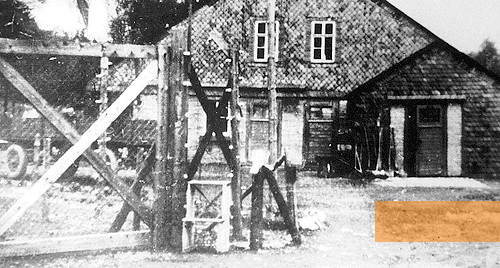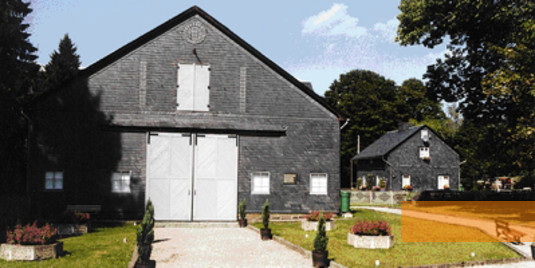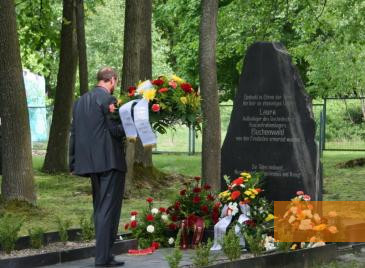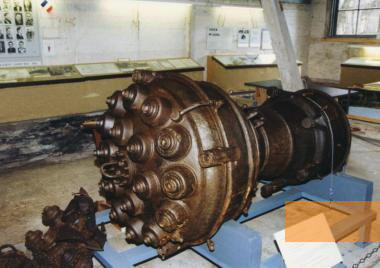Prisoners of the Buchenwald concentration camp had to construct the »Vorwerk Mitte«, a production site for V-2 rockets, in an underground slate mine in the Thuringian town of Schmiedebach. The strenuous forced labour and atrocious conditions at the »Laura« satellite camp led to a high death rate among the prisoners. Since 1979, a memorial has commemorated their fate.
In August 1943, the British air force attacked the V-2 rocket production site in Peenemünde. As a consequence, the National Socialist leadership decided to decentralise the production of V-2 rockets and move it below ground. Several underground production sites were established in Central Germany. Part of the production was moved to a slate mine in Schmiedebach. The mine was confiscated by the SS and shortly afterwards, an underground V-2 production and storage site was set up, and later extended to include a test site for V-2 rocket engines. The SS deployed prisoners of the Buchenwald concentration camp: they had to extend the slate mine and construct the »Vorwerk Mitte« production site. The forced labourers had to dig tunnels at a depth of about 250 metres, lay tracks and conduct concrete and excavation work. After the »Vorwerk Mitte« was completed, they also had to work there. The SS ordered the establishment of the »Laura« satellite camp for the prisoners on a former farm estate. A large barn was converted to the main accommodation block. Due to the regularly incoming transports from Buchenwald, the camp was completely overcrowded by the end of 1943, housing a total of about 1,200 prisoners. At the time, up to 600 men were crowded into the barn. After a few weeks, most of them were too ill or too weak to work due to the physically strenuous work and the harsh living conditions.
Most of the over 2,500 concentration camp prisoners who had to perform forced labour at the »Vorwerk Mitte« came from France, Belgium, the Soviet Union and Poland; there were also about 170 Italian military internees incarcerated there. In the final phase of the war, »Laura« served as a collection camp for approximately 200 Polish Jews. Over 500 prisoners died in the satellite camp and at the arms production site close to Schmiedebach. Alone 450 of them died of the dreadful conditions between the winter of 1943/1944 and March 1944. It is not known how many of the 550 prisoners who were transferred to Mittelbau-Dora and Bergen-Belsen died.
In 1956, a monument was set up on the former camp premises. From 1965 on, a school project group researched the history of the »Laura« satellite camp. In 1979, a collection of documents was created, based on the research results of the school project group; that same year, a memorial was opened. In 1991/1992, the memorial was redesigned and its exhibition revised. The memorial is located in the barn which once served as prisoner living quarters. The remaining barracks and camp buildings were restored and accordingly converted. New artefacts and a restored V-2 rocket engine were put up on display in 1998. In September 2009, in a ceremony yet unprecedented in Germany, an urn containing the remains of a former prisoner were interred on the memorial premises. It had been the wish of Dutchman Herman van Hasselt to be buried in Schmiedebach, where he survived the war as a twenty-year-old forced labourer.
- Name
- Gedenkstätte »Laura«
- Address
-
Schmiedebach, Fröhliches Tal
07349 Lehesten - Phone
- +49 (0)36653 26 46 75
- Web
- http://kz-gedenkstaette-laura.de
- info@kz-gedenkstaette-laura.de
- Open
- April to October Wednesday to Friday 2 p.m. to 5.30 p.m.,Saturday, Sunday and holidays 10 a.m. to 5.30 p.m.
- Possibilities
- Guided tours, workshops for school groups, lectures, commemorative events





